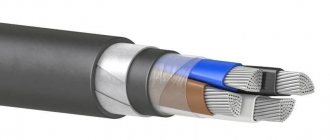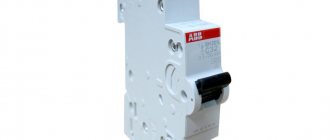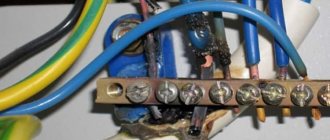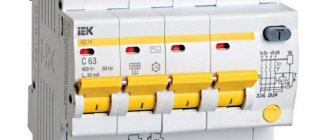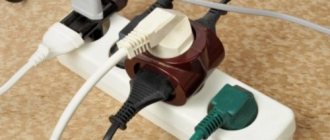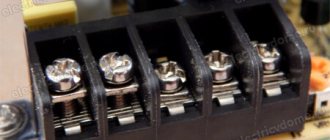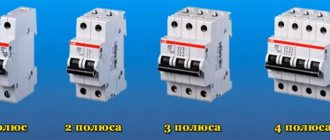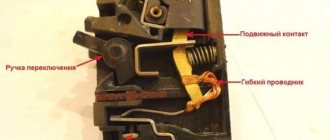General information about machines
Automatic switchboards
As a rule, automatic switches contain three types of electrical circuit releases: thermal, electromagnetic and mechanical. The first is designed to protect electrical circuits from overcurrent, the second - from short circuits in load circuits, the third - for operational switching of electrical circuits.
There are electrical circuit breakers that perform protective functions against overload and electric shock (ES). These are switches controlled by differential current with built-in protection against current overloads - difavtomats (DV).
Main technical characteristics of automatic circuit breakers (AB)
Ratings of machines for various electrical networks
Rated voltage is the value set by the manufacturer at which the AV’s performance is determined.
Rated current is the current established by the manufacturer that the AV is capable of conducting in continuous mode, in which the main contacts remain closed at the specified control ambient temperature (standard +30 °C).
The switch frequency is the industrial frequency for which the device is designed and to which the values of other characteristics correspond.
The rated maximum breaking capacity is the value of the ET, which can turn off the AV while maintaining its functionality.
The current limiting class is characterized by the shutdown time between the beginning of the circuit breaker opening and the end of the arc time. There are three classes of current limiting:
- the shutdown time of class 3 AB occurs within 2.5 – 6 ms;
- 2 classes – 6–10 ms;
- Class 1 – more than 10 ms.
There are several types of protective (time-current) characteristics of AV, the most popular are B, C and D
| Type of protective characteristic | Range of instantaneous tripping currents, reduced to the rated value of the current AB | Purpose |
| A | from 1.3In | To protect circuits in which temporary overcurrents cannot occur during normal operation. |
| IN | from 3In to 5In | To protect circuits in which minor temporary current overloads are allowed in normal operation. |
| WITH | from 5In to 10In | To protect circuits in which moderate temporary current overloads are allowed in normal operation. |
| D | from 10In to 20In | To protect circuits with significant temporary current overloads in normal operation. |
| K | from 12 I | For protecting industrial circuits using inductive loads. |
| Z | from 4 In | To protect industrial circuits using industrial electronic equipment as a load. |
Differential circuit breakers
Differential circuit breaker
Rated residual current IΔn – the value of the residual current specified by the manufacturer, at which the DV must operate under specified conditions.
Rated non-breaking residual current IΔn0 – the value of the non-breaking residual current specified by the manufacturer, at which the motor does not operate under specified conditions.
The rated differential maximum making and breaking capacity IΔm0 is the effective value of the alternating component of the expected differential current, which the DV can turn on, conduct and turn off.
There are three types of DV:
- S – with differential current response time delay.
- AC – operation is ensured with a sinusoidal alternating differential current, either applied abruptly or slowly growing.
- A – ensures operation with differential sinusoidal alternating current and differential pulsating direct current applied in an abrupt manner or slowly increasing.
Unacceptable mistakes when purchasing
The most common mistakes when choosing and purchasing an input circuit breaker are ignorance of the principles of its operation and choosing a machine rating lower or higher than the required value. If you choose a machine with a lower rating, then it is possible that the protection will trigger falsely and shut down the entire apartment due to one device. If you select a rating higher than the required value, it may work after the wire insulation or devices inside the electrical panel overheat and begin to melt or burn.
There are also “professionals” who connect two single-pole circuit breakers instead of a two-terminal circuit, not knowing that this violates electrical safety requirements and the PUE prohibits such a connection.
If you have doubts about the selection and installation of such a device, you should contact a professional electrician and rest assured that the correct choice and safe installation.
Table for calculating the power of the machine during electrical installation work
The electrical installation work we carry out is always high quality and affordable. We can help in calculating the power of machines (circuit breakers) and in their installation. How to choose a machine?
What to consider?
first, when choosing a machine, its power,
the total power of loads connected on a permanent basis to the automatically protected wiring/network is determined. The resulting total power is increased by the consumption coefficient, which determines the possible temporary excess of power consumption due to the connection of other, initially unaccounted for electrical appliances.
second connection type
An example of how you can calculate the load in a kitchen
- electric kettle (1.5 kW),
- microwaves (1kW),
- refrigerator (500 Watt),
- hoods (100 watt).
The total power consumption will be 3.1 kW. To protect such a circuit, you can use a 16A circuit breaker with a rated power of 3.5 kW. Now let’s imagine that a coffee machine (1.5 kW) was installed in the kitchen and connected to the same electrical wiring. The total power removed from the wiring when connecting all of these electrical appliances in this case will be 4.6 kW, which is more than the power of a 16 Amp auto switch, which, when all devices are turned on, it will simply turn off due to excess power and leave all devices without power, including the refrigerator.
We provide a guarantee for all types of services.
It may be useful: installation of sockets and switches, installation of chandeliers, complete repair of electrical networks
Call an electrician in the city of Cherkassy, all types of electrical installation.
tel.
tel.
tel.
Become our client and you will be convinced of the quality of our services.
master-tok.net.ua
Selection of circuit breaker rating for current and load power
To select a suitable machine, it is convenient to calculate the current per kilowatt of load power and draw up the corresponding table. Applying formula (2) and a power factor of 0.95 for a voltage of 220 V, we obtain:
1000 W / (220 V x 0.95) = 4.78 A
Considering that the voltage in our electrical networks often does not reach the required 220 V, it is quite correct to take the value of 5 A per 1 kW of power. Then the table of current versus load will look like this in Table 1:
| power, kWt | 2 | 4 | 6 | 8 | 10 | 12 | 14 | 16 |
| Current strength, A | 10 | 20 | 30 | 40 | 50 | 60 | 70 | 80 |
This table gives an approximate estimate of the strength of alternating current flowing through a single-phase electrical network when household electrical appliances are turned on. It should be remembered that this refers to peak power consumption, not average. This information can be found in the documentation supplied with the electrical product. In practice, it is more convenient to use the table of maximum loads, which takes into account the fact that machines are produced with a certain current rating (Table 2):
| Connection diagram | Current ratings of automatic machines | |||||||
| 10 A | 16 A | 20 A | 25 A | 32 A | 40 A | 50 A | 63 A | |
| Single-phase, 220 V | 2.2 kW | 3.5 kW | 4.4 kW | 5.5 kW | 7.0 kW | 8.8 kW | 11 kW | 14 kW |
| Three-phase, 380 V | 6.6 kW | 10,6 | 13,2 | 16,5 | 21,0 | 26,4 | 33,1 | 41,6 |
For example, if you need to find out how many amperes a machine needs for a power of 15 kW with a three-phase current, then we look in the table for the nearest larger value - it is 16.5 kW, which corresponds to a machine with a capacity of 25 amperes.
In reality, there are limitations on the allocated power. In particular, in modern urban apartment buildings with an electric stove, the allocated power is from 10 to 12 kilowatts, and a 50 A automatic machine is installed at the entrance. It is reasonable to divide this power into groups, taking into account the fact that the most energy-intensive appliances are concentrated in the kitchen and bathroom. Each group is equipped with its own machine, which eliminates the complete loss of power to the apartment in the event of an overload on one of the lines.
In particular, under an electric stove (or hob) it is advisable to make a separate input and install a 32 or 40 ampere machine (depending on the power of the stove and oven), as well as a power outlet with the corresponding rated current. You should not connect other consumers to this group. Both the washing machine and the air conditioner should have a separate line - a 25 A machine will be sufficient for them.
The question of how many sockets can be connected to one machine can be answered in one phrase: as many as you like. The sockets themselves do not consume electricity, that is, they do not create a load on the network. You just need to make sure that the total power of simultaneously switched on electrical appliances corresponds to the cross-section of the wire and the power of the machine, which will be discussed below.
For a private house or cottage, the input machine is selected depending on the allocated power. Not all owners are able to obtain the desired number of kilowatts, especially in regions with limited power grid capabilities. But in any case, as for city apartments, the principle of dividing consumers into separate groups remains.
Introductory machine for a private home
Selecting a circuit breaker by current
According to the rated current AB
The industry produces a wide variety of circuit breakers with rated current: 0.5A; 1A; 1.6A; 2A; 3.15A; 4A; 5A; 6A; 10A; 16A; 20A; 25A; 32A; 40A; 50A; 63A. In everyday life, it is mainly used from 6A to 40A.
When purchasing an AV, you need to choose a rating so that it operates until the moment when the current does not exceed the capabilities of the wiring.
Therefore, you need to know what cross-section you need to lay the wire (cable) to the consumer or group of consumers and their power. The nominal value of AB will depend on this.
| Rated current of the circuit breaker, A | Electrical circuit load, 220 V |
| 10 | Lighting, alarm |
| 16 | General purpose sockets |
| 25 | Air conditioners, water heaters |
| 32 | Electric stoves, ovens |
| 40; 50 | General input |
What is the danger of a cable mismatch with the network load?
When calculating the load on the electrical network, you must remember that the calculation of the current load (the amount of current in the network during operation of an electrical appliance) of an individual household appliance (consumer) and a group of several consumers differ from each other.
In addition, the calculation of the load for a single-phase power supply (220 volts) differs from the calculation of a three-phase power supply (380 volts). Let's begin by analyzing the calculation of the electrical network load in a single-phase network with an operating voltage of 220 Volts.
Using the above formulas, you can calculate the power of the electrical network and the value of the operating current in the network. All that remains is to use the obtained values to select the cross-section of the electrical cable that can be used for the calculated wiring in the apartment.
It's quite simple. In the electrician's handbook, PUE rules for electrical installations, everything is done for us. Using the table below, look for the value of the calculated load current or the calculated power of the network and select the cross-section of the electrical cable. The table is given for copper cores of cables or, more simply, copper cable, because the use of aluminum cables in electrical wiring of residential premises is prohibited. (read PUE ed. 7)
| Laid open | |||
| Cable cross-section | Copper conductors | ||
| mm2 | Load current | Power kW | |
| A | 220 V | 380 V | |
| 0,5 | 11 | 2,4 | |
| 0,75 | 15 | 3,3 | |
| 1 | 17 | 3,7 | 6,4 |
| 1,5 | 23 | 5 | 8,7 |
| 2 | 26 | 5,7 | 9,8 |
| 2,5 | 30 | 6,6 | 11 |
| 4 | 41 | 9 | 15 |
| 5 | 50 | 11 | 19 |
| 10 | 80 | 17 | 30 |
| 16 | 100 | 22 | 38 |
| 25 | 140 | 30 | 53 |
| 35 | 170 | 37 | 64 |
| Installed in a pipe | |||
| Cable cross-section | Copper conductors | ||
| mm2 | Load current | Power kW | |
| A | 220 V | 380 V | |
| 0,5 | |||
| 0,75 | |||
| 1 | 14 | 3 | 5,3 |
| 1,5 | 15 | 3,3 | 5,7 |
| 2 | 19 | 4,1 | 7,2 |
| 2,5 | 21 | 4,6 | 7,9 |
| 4 | 27 | 5,9 | 10 |
| 5 | 34 | 7,4 | 12 |
| 10 | 50 | 11 | 19 |
| 16 | 80 | 17 | 30 |
| 25 | 100 | 22 | 38 |
| 35 | 135 | 29 | 51 |
TABLE 1.
But it is equally important to choose the correct cross-section of the electrical cable. Otherwise, if the total power exceeds the rated value that the conductor can withstand, this will lead to a significant increase in the temperature of the latter
As a result, the insulating layer will begin to melt, which can lead to a fire.
To more clearly imagine the consequences of a mismatch between the wiring cross-section and the total power of the devices connected to the network, let’s consider this example.
New owners, having bought an apartment in an old house, install several modern household appliances in it, giving a total load on the circuit equal to 5 kW. The current equivalent in this case will be about 23 A. In accordance with this, a 25 A circuit breaker is included in the circuit. It would seem that the choice of the circuit breaker in terms of power was made correctly, and the network is ready for operation.
If the owner is not nearby at this moment, the melted insulation will cause a short circuit after some time, which will finally trigger the machine, but the flames from the wiring may already spread throughout the house.
Cables GOST 31996–2012
When choosing a machine, it is necessary to take into account the characteristics of the cables. The most important is the permissible current (Iperm). It shows at what maximum current the cable can operate throughout its entire service life. This table from the PUE contains information about permissible cable currents depending on the material and conditions of cable laying.
Permissible currents for cable depending on materials
| Open wiring | Cable cross-section, mm2 | Closed wiring | ||||||||||
| Copper | Aluminum | Copper | Aluminum | |||||||||
| Current A | Power, kWt | Current A | Power, kWt | Current A | Power, kWt | Current A | Power, kWt | |||||
| 220 V | 380 V | 220 V | 380 V | 220 V | 380 V | 220 V | 380 V | |||||
| 11 | 2.4 | — | — | — | — | 0.5 | — | — | — | — | — | — |
| 15 | 3.3 | — | — | — | — | 0.75 | — | — | — | — | — | — |
| 17 | 3.7 | 6.4 | — | — | — | 1 | 14 | 3 | 5.3 | — | — | — |
| 23 | 5 | 8.7 | — | — | — | 1.5 | 15 | 3.3 | 5.7 | — | — | — |
| 26 | 5.7 | 9.8 | 21 | 4.6 | 7.9 | 2 | 19 | 4.1 | 7.2 | 14 | 3 | 5.3 |
| 30 | 6.6 | 11 | 24 | 5.2 | 9.1 | 2.5 | 21 | 4.6 | 7.9 | 16 | 3.5 | 6 |
| 41 | 9 | 15 | 32 | 7 | 12 | 4 | 27 | 5.9 | 10 | 21 | 4.6 | 7.9 |
| 50 | 11 | 19 | 39 | 8.5 | 14 | 6 | 34 | 7.4 | 12 | 26 | 5.7 | 9.8 |
| 80 | 17 | 30 | 60 | 13 | 22 | 10 | 50 | 11 | 19 | 38 | 8.3 | 14 |
| 100 | 22 | 38 | 75 | 16 | 28 | 16 | 80 | 17 | 30 | 55 | 12 | 20 |
| 140 | 30 | 53 | 105 | 23 | 39 | 25 | 100 | 22 | 38 | 65 | 14 | 24 |
| 170 | 37 | 64 | 130 | 28 | 49 | 35 | 130 | 29 | 51 | 75 | 16 | 28 |
From this table you can find the required cable cross-section and permissible current depending on the wiring conditions, open or buried. For example, the power of all appliances in the apartment is 9 kW. For open single-phase copper wiring, the wire cross-section is 4 mm 2, current 41A, for closed - the nearest higher power value is 11 kW, cross-section 10 mm 2, current 50A. The nearest lower rating of the circuit breaker is 32A.
If there is doubt about the quality of the electrical wiring, then it is better to exercise caution and choose a machine with a rating lower than the value in the table.
The residential network has a branched structure: a current of different strength will flow in each branch, so the wires have different cross-sections. If you install one circuit breaker only at the entrance, it will not be able to protect individual sections of the wiring from overload. If the entire network is laid with a cable of the same cross-section, then this is an unjustified financial expense. The best solution would be to install the appropriate current on each section of the machine. The figure shows an approximate structure.
Installation of machines for the appropriate current
The figure clearly shows the load on each section and the cross-section of the wire. By installing appropriate circuit breakers, you can reliably protect the entire network from short circuits or overloads. In addition, at any time it is possible to select and disable one or another section, maintaining the functionality of the rest of the network.
When using powerful asynchronous motors in everyday life, especially 3-phase ones, for example, power tools, it is advisable to turn them on through a separate circuit breaker, since they have a large starting current, and when operating through a common circuit breaker, a power outage may occur even during normal operation of the equipment.
Load calculation
At the initial stage, it is recommended to make an adjustment for the load. This was mentioned above, but let us repeat that situations rarely arise in everyday life when all energy consumers turn on at the same time. Most often, some devices work and others do not. Therefore, to clarify, the resulting cross-sectional value should be multiplied by the demand coefficient (Kc). If you are sure that you will operate all devices at once, then you do not need to use the specified coefficient.
Table: Demand coefficients of various consumers (Kс).
| Receiver name | Demand factor |
| Lighting of outdoor switchgear (open switchgear): | |
| with one | 0,5 |
| with several | 0,35 |
| Room lighting | 0,6-0,7 |
| TV | 0,7 |
| Consumer electronics | 0,2 |
| Fridge | 0,8 |
| Washing machine | 0,1 |
| Vacuum cleaner | 0,1 |
| Transformer cooling | 0,8-0,85 |
| Compressors | 0,4 |
| Charging device | 0,12 |
| Heating and electric heating | 1,0 |
Calculation of circuit breakers for new electrical wiring
Before the calculation, let's remember a little why we need a circuit breaker. First of all, to protect against short circuits and circuit overloads. What does the circuit breaker protect? Protects electrical wiring and connection devices (sockets and switches) from overheating and fire.
Depending on the purpose of the circuit and its short circuit protection, we select the type of circuit breaker. Here we do without calculations. But now we’ll look into the calculation of exceeding the permissible load.
On the one hand, the circuit breaker must have a rated current or the current of the circuit breaker is greater than or equal to the current at the maximum load in the circuit.
For example, your electrical circuit consists of 9 outlets with a planned maximum load of 3150 W. When I talk about maximum load, I mean that the planned appliances will be plugged into all sockets.
The current in the circuit will be equal to 14.3 Amperes. Calculation formula from school:
Go ahead. On the other hand, the rated current of the circuit breaker cannot be unlimitedly large. We remember that the circuit breaker protects the cable from overheating. Consequently, the upper permissible value of the rated current of the circuit breaker must be such that the wires do not heat up, and this value is called the permissible cable current, or rather, the permissible current of the conductors.
As a result, we get a simple condition:
Selecting a machine according to cable cross-section
To select a switch according to the cable cross-section, you should keep in mind that DDT standards for wires with different cross-sections and from different materials differ from each other.
The special rules for master electricians “Rules for electrical installations”, or PES, contain a table with which you can calculate the load for a specific package.
| Open wiring | Cable cross-section, mm | Closed wiring | ||||||||||
| Copper | Aluminum | Copper | Aluminum | |||||||||
| Current, A | power, kWt | Current, A | power, kWt | Current, A | power, kWt | Current, A | power, kWt | |||||
| 220 | ||||||||||||
IN
To select the correct machine according to the cable cross-section, you should determine the main network voltage in the place where the wiring with the protective device is installed.
When choosing a machine according to the cable cross-section, you should pay attention not only to the diameter and thickness of the wire or wires, but also to the place where the wiring is located (in the wall, with or without a special recess for cords, in areas of stairs or window openings, and so on) . Depending on the location of the wiring, the power of the selected machine across the cable cross-section may vary.
Performance
Its service life largely depends on how quickly the switch turns on and closes its contacts. However, is it possible to determine at home how well your device corresponds to this parameter without disassembling the case itself and without resorting to specialized laboratory tests?
Of course you can. Everything is done very simply. Take a regular battery-powered indicator screwdriver. Exactly with the battery.
It is usually used for testing and determining the integrity of the circuit. Although knowledgeable people use this useful device in many other ways. Read about which ones in a separate article.
Use the tip of a screwdriver to touch the upper contact, pressing the metal patch on the handle from above, and with the finger of your other hand, touch the lower contact of the switch.
After which, you slowly begin to turn on the machine, cocking the tongue.
The contact should appear (the LED in the screwdriver will light up) only at the very last moment, when the device has already clicked.
If the same manipulation is done with another switch, the light comes on when the power lever reaches the middle of the stroke.
It turns out that the device is not yet cocked, but the contacts are already closed. This is what this sometimes leads to under heavy load (view of the contacts from inside the machine):
This ultimately affects the rapid wear and burnout of contacts. While the quick-start mechanism increases the service life of the product by almost 30%.
Formula for calculating cable cross-section by power
Allows you to select the cross section based on power consumption and voltage.
For single-phase electrical networks (220 V):
I = (P × K and ) / (U × cos(φ) )
Where:
- cos(φ) - for household appliances, equals 1
- U - phase voltage, can range from 210 V to 240 V
- I - current strength
- P - total power of all electrical appliances
- K and - simultaneity coefficient, for calculations the value is taken as 0.75
For 380 in three-phase networks:
I = P / (√3 × U × cos(φ))
Where:
- Cos φ—phase angle
- P is the sum of the power of all electrical appliances
- I is the current strength by which the cross-sectional area of the wire is selected
- U - phase voltage, 220V
Concept of electrical network load
The circuit of any standard electrical network in an apartment or private house is divided into several main groups. For each group, a wire or cable of a certain cross-section and an automatic protective device, the rating of which is calculated in advance, are provided.
To correctly select the required parameters for the cross-section of the cable and the machine, calculations of the expected loads for a given electrical network are carried out. Current load is the amount of current generated in the network during operation of the devices. Calculation of the current load for an individual consumer will differ markedly from the same calculations performed for a group of household appliances.
You should also take into account the difference in the calculated loads when connecting single-phase (220V) and three-phase (380V) power. These factors have a direct impact on the correct choice of circuit breakers and cable cross-sections.
Main selection criteria
In order to choose the right introductory machine (VA), you need to know what characteristics you should pay attention to when purchasing
Rated current
This is the most important characteristic when choosing an input protective device. This property of the device indicates the maximum current, if exceeded, the power will be turned off within a certain time.
Regardless of whether the machine is introductory or provides protection for a specific line (wire), its calculation is made based on the maximum power of electricity consumers. The rating of the input device is selected by calculating the power (or current) of all consumers when simultaneously connected to the network, for greater safety, reducing the resulting number by 10-15%, rounding down to a lower value.
Number of poles
There are machines with different numbers of poles. Single-pole ones are used to protect individual lines. The functions of the input circuit breaker are usually performed by two, three or four-pole circuit breakers.
An important rule that will help you choose the number of poles is that for single-phase networks, two-pole circuit breakers are used, and for three-phase networks, three or four-port circuit breakers are used. Two-pole switches are made with a lever and a shutdown mechanism common to both poles. That is, in an emergency situation, two poles are disconnected at once (usually a phase is connected to one terminal, and zero to the second)
Such devices are often used in single-phase networks of residential premises of apartment buildings
That is, in an emergency, two poles are disconnected at once (usually a phase is connected to one terminal, and zero to the second). Such devices are often used in single-phase networks of residential premises of apartment buildings
Two-pole switches are made with a lever and a shutdown mechanism common to both poles. That is, in an emergency, two poles are disconnected at once (usually a phase is connected to one terminal, and zero to the second). Such devices are often used in single-phase networks of residential premises of apartment buildings.
A three-pole (or four-pole) machine is used when introducing electrical cables into private houses with a three-phase network, as well as in industrial buildings and even in some apartments. A phase is connected to each terminal of the device (and zero if it is a four-terminal network). It, like a two-terminal switch, has one common lever for all poles and, in case of overload, turns off the power in all phases.
Time-current characteristic
It characterizes the instantaneous tripping current and is most often indicated on the device by the Latin letters B, C or D. The sensitivity of the protective device to inrush currents of electrical appliances and equipment depends on the time-current characteristics. For an input circuit breaker, this property is important, since it affects the operation of lower groups of circuit breakers.
The following types of machines are most often used based on their time-current characteristics:
- B – at a current value 3 - 5 times higher than the rated value, the electromagnetic switch of the device will operate and it will instantly turn off;
- C – the electromagnetic release will turn off the device when the current exceeds 5-10 times;
- D – will work when the current exceeds 10-20 times the rated current.
For the input circuit breaker in residential premises, devices with a time-current characteristic of type C are used, since most devices in the home do not have large starting currents and will not have a negative impact on the electrical network of the apartment or house.
The response characteristics of each device are indicated in the passport and instructions of the circuit breaker manufacturer.
Mounting method
All circuit breakers have a standard mounting and are placed on a DIN rail in the electrical panel. The same rule applies to introductory machines. The exception is special devices for industrial purposes, which can be mounted without a DIN rail on special fasteners.
Switch brand
When choosing an input protective switch, as well as in the case of choosing any electrical devices, it is important to focus on a well-known manufacturer that has earned recognition. Such manufacturers provide a quality guarantee for their devices and produce reliable, durable and safe circuit breakers. The most popular machines today include machines from the following manufacturers:
The most popular machines today include machines from the following manufacturers:
Sections and automata. For sockets 1.5 mm² and AB 16A or 2.5 mm² and AB 20A?
Attention!
Without special education and proper experience, working with electricity can be dangerous!
There are ongoing debates online about whether it is possible to run a copper cable with a cross-section of 1.5 mm² into sockets, protecting it with a 16A circuit breaker, or whether it is possible to protect a copper cable with a cross-section of 2.5 mm² with a circuit breaker of more than 16A. I will try to answer these questions and put an end to this dispute.
For calculations, you can use tables from the PUE, but it’s better to use more convenient tables from GOST 31996-2012 “Power cables with plastic insulation for a rated voltage of 0.66; 1 and 3 kV.”
We will calculate the most common cable for electrical wiring in residential and public buildings - three-core VVGng-LS. The sheath and insulation of the cores of this cable are made of PVC plastic, which has a reduced level of gas and smoke emission and flammability.
Collecting cable tabular data
GOST 31996-2012, clause 10.8: “The permissible current loads of cables during normal operation and at 100% load factor of the cables should not exceed those indicated in tables 19, 20, 21 and 22, unless otherwise stated in the technical specifications for the cables specific brands." We select a table suitable for our cable from those listed. This is table 19 “Permissible current loads of cables with copper conductors with insulation made of polyvinyl chloride plastic compounds and halogen-free polymer compositions”:
Calculation of permissible current loads is carried out for the following design conditions: ambient temperature when laying cables in air 25°C
, when laying in the ground - 15°C;
Wiring in the house is done with three-core cables, in other words, multi-core. Our installation will be in the air (not in the ground).
With a nominal core cross-section of 1.5 mm², the permissible current is 21 A
, at 2.5 mm² -
27
A.
Permissible core heating temperature in normal operation is 70°C
(Table 18).
GOST 31996-2012, clause 10.9: “Permissible current loads of cables in overload mode
can be calculated by multiplying the values given in tables 19, 21 by a factor of 1.13 for land and by a factor of 1.16 for air; indicated in tables 20, 22, by a factor of 1.17 for land and by a factor of 1.20 for air.”
The permissible overload factor of our cable is 1,16
.
PUE, clause 1.3.9, Table 1.3.3. “Correction factors for currents for cables, bare and insulated wires and busbars depending on ground and air temperatures”:
The design conditions for permissible current loads include an ambient temperature of +25°C. The operating temperature in channels and panels with normally loaded cables and wires, and especially inside boxes under the ceiling, will be higher, as a rule, about +35°C. Using the table above we find the corresponding correction factor (+25, +70 - +35) - 0,88
.
We make a calculation
- Emergency current for 1.5 mm²: 21 x 1.16 = 24.36 A, for 2.5 mm²: 27 x 1.16 = 31.32 A.
- Current in emergency mode, taking into account ambient temperature +35°C for 1.5 mm²: 24.36 x 0.88 = 21.44
A, for 2.5 mm²: 31.32 x 0.88 =
27.56
A .
Example of cable cross-section calculation
Task: to power the heating element with a power of W=4.75 kW with copper wire in the cable channel. Current calculation: I = W/U. We know the voltage: 220 volts. According to the formula, the flowing current I = 4750/220 = 21.6 amperes.
We focus on copper wire, so we take the value of the diameter of the copper core from the table. In the 220V column - copper conductors we find a current value exceeding 21.6 amperes, this is a line with a value of 27 amperes. From the same line we take the cross-section of the conductive core equal to 2.5 squares.
Calculation of the required cable cross-section based on the type of cable or wire
| № | Number of cores, section mm. Cables (wires) | Outer diameter mm. | Pipe diameter mm. | Permissible continuous current (A) for wires and cables during installation: | Permissible continuous current for rectangular copper busbars (A) PUE | ||||||||
| VVG | VVGng | KVVG | KVVGE | NYM | PV1 | PV3 | PVC (HDPE) | Met.tr. Du | in the air | in the ground | Section, tires mm | Number of buses per phase | |
| 1 | 1x0.75 | 2,7 | 16 | 20 | 15 | 15 | 1 | 2 | 3 | ||||
| 2 | 1x1 | 2,8 | 16 | 20 | 17 | 17 | 15x3 | 210 | |||||
| 3 | 1x1.5 | 5,4 | 5,4 | 3 | 3,2 | 16 | 20 | 23 | 33 | 20x3 | 275 | ||
| 4 | 1x2.5 | 5,4 | 5,7 | 3,5 | 3,6 | 16 | 20 | 30 | 44 | 25x3 | 340 | ||
| 5 | 1x4 | 6 | 6 | 4 | 4 | 16 | 20 | 41 | 55 | 30x4 | 475 | ||
| 6 | 1x6 | 6,5 | 6,5 | 5 | 5,5 | 16 | 20 | 50 | 70 | 40x4 | 625 | ||
| 7 | 1x10 | 7,8 | 7,8 | 5,5 | 6,2 | 20 | 20 | 80 | 105 | 40x5 | 700 | ||
| 8 | 1x16 | 9,9 | 9,9 | 7 | 8,2 | 20 | 20 | 100 | 135 | 50x5 | 860 | ||
| 9 | 1x25 | 11,5 | 11,5 | 9 | 10,5 | 32 | 32 | 140 | 175 | 50x6 | 955 | ||
| 10 | 1x35 | 12,6 | 12,6 | 10 | 11 | 32 | 32 | 170 | 210 | 60x6 | 1125 | 1740 | 2240 |
| 11 | 1x50 | 14,4 | 14,4 | 12,5 | 13,2 | 32 | 32 | 215 | 265 | 80x6 | 1480 | 2110 | 2720 |
| 12 | 1x70 | 16,4 | 16,4 | 14 | 14,8 | 40 | 40 | 270 | 320 | 100x6 | 1810 | 2470 | 3170 |
| 13 | 1x95 | 18,8 | 18,7 | 16 | 17 | 40 | 40 | 325 | 385 | 60x8 | 1320 | 2160 | 2790 |
| 14 | 1x120 | 20,4 | 20,4 | 50 | 50 | 385 | 445 | 80x8 | 1690 | 2620 | 3370 | ||
| 15 | 1x150 | 21,1 | 21,1 | 50 | 50 | 440 | 505 | 100x8 | 2080 | 3060 | 3930 | ||
| 16 | 1x185 | 24,7 | 24,7 | 50 | 50 | 510 | 570 | 120x8 | 2400 | 3400 | 4340 | ||
| 17 | 1x240 | 27,4 | 27,4 | 63 | 65 | 605 | 60x10 | 1475 | 2560 | 3300 | |||
| 18 | 3x1.5 | 9,6 | 9,2 | 9 | 20 | 20 | 19 | 27 | 80x10 | 1900 | 3100 | 3990 | |
| 19 | 3x2.5 | 10,5 | 10,2 | 10,2 | 20 | 20 | 25 | 38 | 100x10 | 2310 | 3610 | 4650 | |
| 20 | 3x4 | 11,2 | 11,2 | 11,9 | 25 | 25 | 35 | 49 | 120x10 | 2650 | 4100 | 5200 | |
| 21 | 3x6 | 11,8 | 11,8 | 13 | 25 | 25 | 42 | 60 | Permissible continuous current for rectangular copper bars (A) Schneider Electric IP30 | ||||
| 22 | 3x10 | 14,6 | 14,6 | 25 | 25 | 55 | 90 | ||||||
| 23 | 3x16 | 16,5 | 16,5 | 32 | 32 | 75 | 115 | ||||||
| 24 | 3x25 | 20,5 | 20,5 | 32 | 32 | 95 | 150 | ||||||
| 25 | 3x35 | 22,4 | 22,4 | 40 | 40 | 120 | 180 | Section, tires mm | Number of buses per phase | ||||
| 26 | 4x1 | 8 | 9,5 | 16 | 20 | 14 | 14 | 1 | 2 | 3 | |||
| 27 | 4x1.5 | 9,8 | 9,8 | 9,2 | 10,1 | 20 | 20 | 19 | 27 | 50x5 | 650 | 1150 | |
| 28 | 4x2.5 | 11,5 | 11,5 | 11,1 | 11,1 | 20 | 20 | 25 | 38 | 63x5 | 750 | 1350 | 1750 |
| 29 | 4x50 | 30 | 31,3 | 63 | 65 | 145 | 225 | 80x5 | 1000 | 1650 | 2150 | ||
| 30 | 4x70 | 31,6 | 36,4 | 80 | 80 | 180 | 275 | 100x5 | 1200 | 1900 | 2550 | ||
| 31 | 4x95 | 35,2 | 41,5 | 80 | 80 | 220 | 330 | 125x5 | 1350 | 2150 | 3200 | ||
| 32 | 4x120 | 38,8 | 45,6 | 100 | 100 | 260 | 385 | Permissible continuous current for rectangular copper bars (A) Schneider Electric IP31 | |||||
| 33 | 4x150 | 42,2 | 51,1 | 100 | 100 | 305 | 435 | ||||||
| 34 | 4x185 | 46,4 | 54,7 | 100 | 100 | 350 | 500 | ||||||
| 35 | 5x1 | 9,5 | 10,3 | 16 | 20 | 14 | 14 | ||||||
| 36 | 5x1.5 | 10 | 10 | 10 | 10,9 | 10,3 | 20 | 20 | 19 | 27 | Section, tires mm | Number of buses per phase | |
| 37 | 5x2.5 | 11 | 11 | 11,1 | 11,5 | 12 | 20 | 20 | 25 | 38 | 1 | 2 | 3 |
| 38 | 5x4 | 12,8 | 12,8 | 14,9 | 25 | 25 | 35 | 49 | 50x5 | 600 | 1000 | ||
| 39 | 5x6 | 14,2 | 14,2 | 16,3 | 32 | 32 | 42 | 60 | 63x5 | 700 | 1150 | 1600 | |
| 40 | 5x10 | 17,5 | 17,5 | 19,6 | 40 | 40 | 55 | 90 | 80x5 | 900 | 1450 | 1900 | |
| 41 | 5x16 | 22 | 22 | 24,4 | 50 | 50 | 75 | 115 | 100x5 | 1050 | 1600 | 2200 | |
| 42 | 5x25 | 26,8 | 26,8 | 29,4 | 63 | 65 | 95 | 150 | 125x5 | 1200 | 1950 | 2800 | |
| 43 | 5x35 | 28,5 | 29,8 | 63 | 65 | 120 | 180 | ||||||
| 44 | 5x50 | 32,6 | 35 | 80 | 80 | 145 | 225 | ||||||
| 45 | 5x95 | 42,8 | 100 | 100 | 220 | 330 | |||||||
| 46 | 5x120 | 47,7 | 100 | 100 | 260 | 385 | |||||||
| 47 | 5x150 | 55,8 | 100 | 100 | 305 | 435 | |||||||
| 48 | 5x185 | 61,9 | 100 | 100 | 350 | 500 | |||||||
| 49 | 7x1 | 10 | 11 | 16 | 20 | 14 | 14 | ||||||
| 50 | 7x1.5 | 11,3 | 11,8 | 20 | 20 | 19 | 27 | ||||||
| 51 | 7x2.5 | 11,9 | 12,4 | 20 | 20 | 25 | 38 | ||||||
| 52 | 10x1 | 12,9 | 13,6 | 25 | 25 | 14 | 14 | ||||||
| 53 | 10x1.5 | 14,1 | 14,5 | 32 | 32 | 19 | 27 | ||||||
| 54 | 10x2.5 | 15,6 | 17,1 | 32 | 32 | 25 | 38 | ||||||
| 55 | 14x1 | 14,1 | 14,6 | 32 | 32 | 14 | 14 | ||||||
| 56 | 14x1.5 | 15,2 | 15,7 | 32 | 32 | 19 | 27 | ||||||
| 57 | 14x2.5 | 16,9 | 18,7 | 40 | 40 | 25 | 38 | ||||||
| 58 | 19x1 | 15,2 | 16,9 | 40 | 40 | 14 | 14 | ||||||
| 59 | 19x1.5 | 16,9 | 18,5 | 40 | 40 | 19 | 27 | ||||||
| 60 | 19x2.5 | 19,2 | 20,5 | 50 | 50 | 25 | 38 | ||||||
| 61 | 27x1 | 18 | 19,9 | 50 | 50 | 14 | 14 | ||||||
| 62 | 27x1.5 | 19,3 | 21,5 | 50 | 50 | 19 | 27 | ||||||
| 63 | 27x2.5 | 21,7 | 24,3 | 50 | 50 | 25 | 38 | ||||||
| 64 | 37x1 | 19,7 | 21,9 | 50 | 50 | 14 | 14 | ||||||
| 65 | 37x1.5 | 21,5 | 24,1 | 50 | 50 | 19 | 27 | ||||||
| 66 | 37x2.5 | 24,7 | 28,5 | 63 | 65 | 25 | 38 |
Calculation of cable cross-section. Errors
Greetings, dear readers of the site!
This material will focus on how NOT to choose a cable cross-section.
I often see that the required cable cross-section is chosen based on the number of kilowatts that can be “loaded” on this cable.
Usually the argument goes like this: “A cable with a cross-section of 2.5 mm2 can withstand a current of 27 amperes (sometimes 29 amperes), so we set the machine to 25 A.”
And in practice, sometimes you come across socket groups protected by a 25A circuit breaker, and lighting by a 16A circuit breaker.
This approach when choosing circuit breakers leads to overheating, melting and damage to the insulation, and as a result - to a short circuit and fire.
Let's refer to table 1.3.4. from PUE.
The permissible long-term current for copper wires laid hidden is 25 A. Everything seems to be correct, is it so?
If you install the machine at 25A, which is called “head-on”, and from the course on circuit breakers we remember that the thermal protection of the machine will be able to operate when the rated current is exceeded by 13%, which in our case will be 25x1.13 = 28.25A. And the response time will be more than an hour.
And if there is an overload of 45%, the thermal release will operate in less than 1 hour, i.e. 25Ax1.45=36.25 A. But it can work in an hour.
It is clear that at such currents the cable will simply burn out.
If you install a 16A machine on the lighting, the result will be similar, you can calculate it yourself.
In addition, sockets are produced for a maximum current of 16A, and switches - 10A. If you install overrated circuit breakers on sockets and lighting, this will lead to their melting, destruction of contacts and potentially a fire. I think you've seen melted sockets - the result of connecting a very powerful load that the sockets are not designed to handle.
REMEMBER! In our apartments and houses, socket groups are made with a 2.5 mm2 cable with the installation of a 16A circuit breaker, lighting groups are made with a 1.5 mm2 cable with the installation of a 10A circuit breaker. A lower denomination is possible, but a larger one is not!
A variation of this approach: the machine knocks out, especially for the kitchen outlet group where powerful appliances are connected. In reserve, so that it doesn’t get knocked out , a 32A and even 40A machine is installed. And this is with wiring done with a 2.5 mm2 cable!!! The consequences are obvious and discussed above.
There are also situations when a cable with a larger cross-section (for example, 4 mm2) is laid up to the branch box, and then the lines are separated at 2.5 mm2 each and a 25A or 32A machine is installed in the electrical panel .
The current of the circuit breaker must be selected based on the weakest point in the line , in our example it is a 2.5 mm2 cable. Therefore, such a group still needs to be protected by a 16A machine.
If you set the machine to 25A, then when a load close to 25A is connected to one of the sockets, the cable to the branch box will burn out, but for a cable with a cross-section of 4 mm2 from the branch box to the circuit breaker, this will be normal mode.
All these points must be taken into account when calculating the cable cross-section.
Watch detailed video:
Calculation of cable cross-section.
Errors I recommend reading:
Automatic circuit breakers RCD difavtomat - a detailed guide.
How to choose circuit breakers, RCDs, automatic circuit breakers?
Circuit breakers - selection strategy.
How to calculate the rated current of a circuit breaker?
Calculation of cable cross-section.
Automatic switches - design and operating principle.
Rated current characteristics of circuit breakers.
Should I change the circuit breaker if it gets knocked out?
What is it needed for
The machine is considered a device whose main task is to ensure safe use of the electrical network. He also deals with protecting equipment from overcurrent, which is considered an overload short circuit. Such equipment is turned on and off from an electrical circuit. It is equipped with either an electromagnetic release or a combined type. Thanks to this, the circuit can be protected. Its main advantage is the fact that it allows you to protect an electrical installation or transformer substation from short circuits, network overloads and breakdowns as a result of frequent network outages.
Network protection as the main task of a circuit breaker
It has on its body markings of the rated current, switching capacity, current limiting class, rated breaking capacity and time-current response characteristics of the release system. It can be single-pole, two-pole, three-pole and four-pole and is suitable for the network phases corresponding to the name.
Important! Most often it is used to protect an electric stove or other kitchen heating appliances. It is also used to protect the lighting system with motor and transformer systems
Main selection criteria
In order to choose the right introductory machine (VA), you need to know what characteristics you should pay attention to when purchasing
Rated current
This is the most important characteristic when choosing an input protective device. This property of the device indicates the maximum current, if exceeded, the power will be turned off within a certain time.
Regardless of whether the machine is introductory or provides protection for a specific line (wire), its calculation is made based on the maximum power of electricity consumers. The rating of the input device is selected by calculating the power (or current) of all consumers when simultaneously connected to the network, for greater safety, reducing the resulting number by 10-15%, rounding down to a lower value.
Number of poles
There are machines with different numbers of poles. Single-pole ones are used to protect individual lines. The functions of the input circuit breaker are usually performed by two, three or four-pole circuit breakers.
An important rule that will help you choose the number of poles is that for single-phase networks, two-pole circuit breakers are used, and for three-phase networks, three or four-port circuit breakers are used. Two-pole switches are made with a lever and a shutdown mechanism common to both poles
That is, in an emergency, two poles are disconnected at once (usually a phase is connected to one terminal, and zero to the second). Such devices are often used in single-phase networks of residential premises of apartment buildings
Two-pole switches are made with a lever and a shutdown mechanism common to both poles. That is, in an emergency, two poles are disconnected at once (usually a phase is connected to one terminal, and zero to the second). Such devices are often used in single-phase networks of residential premises of apartment buildings.
A three-pole (or four-pole) machine is used when introducing electrical cables into private houses with a three-phase network, as well as in industrial buildings and even in some apartments. A phase is connected to each terminal of the device (and zero if it is a four-terminal network). It, like a two-terminal switch, has one common lever for all poles and, in case of overload, turns off the power in all phases.
Time-current characteristic
It characterizes the instantaneous tripping current and is most often indicated on the device by the Latin letters B, C or D. The sensitivity of the protective device to inrush currents of electrical appliances and equipment depends on the time-current characteristics. For an input circuit breaker, this property is important, since it affects the operation of lower groups of circuit breakers.
The following types of machines are most often used based on their time-current characteristics:
- B – at a current value 3 - 5 times higher than the rated value, the electromagnetic switch of the device will operate and it will instantly turn off;
- C – the electromagnetic release will turn off the device when the current exceeds 5-10 times;
- D – will work when the current exceeds 10-20 times the rated current.
For the input circuit breaker in residential premises, devices with a time-current characteristic of type C are used, since most devices in the home do not have large starting currents and will not have a negative impact on the electrical network of the apartment or house.
The response characteristics of each device are indicated in the passport and instructions of the circuit breaker manufacturer.
Mounting method
All circuit breakers have a standard mounting and are placed on a DIN rail in the electrical panel. The same rule applies to introductory machines. The exception is special devices for industrial purposes, which can be mounted without a DIN rail on special fasteners.
Selection of circuit breaker by power: table
To select a circuit breaker based on power (P), you need to calculate the load current using the formula, then, based on the data obtained, select a circuit breaker of a larger value.
Example of selecting an automatic switch
First you need to calculate the sum of all powers for which you need to select an AB. A wire is connected to the automatic switch in the apartment panel, which goes to the kitchen, where a 2.2 kW kettle, a 700 W microwave oven, and a 720 W bread maker are connected through sockets. The total power of electricity consumers is 3,620 W = 3.62 kW. We will calculate the current using the formula:
I – current consumption;
P – total power of consumers;
U – network voltage.
I = 3,620/220 = 16.4A
As you can see, the consumed load current is 16.4 A. And based on this, you can select AB. You can take a 16 A automatic machine, but it will work at the very limit. Any machine is designed in such a way that the specified rated current is increased by 13% and if overloaded it will work for some time. Why take an AB that will work to the limit. You need to take it with a reserve. The next AB rating is 20 A.
To determine a more accurate load, you need to look at the passport or take data from the nameplate, which is on all electrical appliances.
Look at the power table to select an AB by rating.
| Connection type | Single phase 220 V, | Three-phase (delta), 380 V | Three-phase (star), 220 V |
| Machine rating, A | |||
| 1 | 200 W | 1 100 W | 700 W |
| 2 | 400 W | 2,300 W | 1,300 W |
| 3 | 700 W | 3,400 W | 2,000 W |
| 6 | 1,300 W | 6,800 W | 4 000W |
| 10 | 2,200 W | 11,400 W | 6,600 W |
| 16 | 3,500 W | 18,200 W | 10,600 W |
| 20 | 4,400 W | 22,800 W | 13,200 W |
| 25 | 5,500 W | 28,500 W | 16,500 W |
| 32 | 7,000 W | 36,500 W | 21,100 W |
| 40 | 8,800 W | 45,600 W | 26,400 W |
| 50 | 11,000 W | 57,000 W | 33,000 W |
| 63 | 13,900 W | 71,800 W | 41,600 W |


